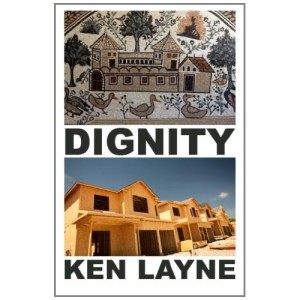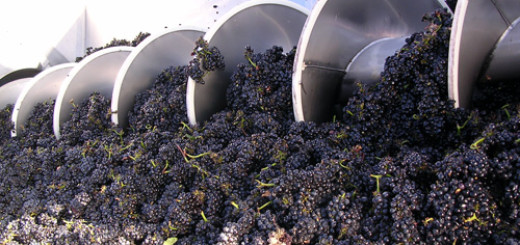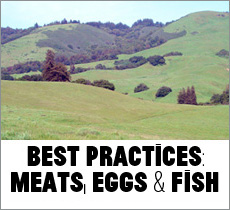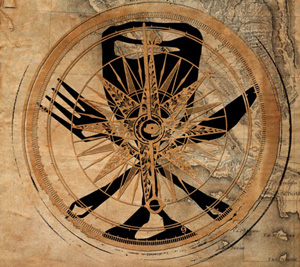“What is the ideal community”
An excerpt from Dignity by Ken Layne

[The following chapter about productive, positive communities rising from the ashes of the California housing bust is one of several letters that constitute Ken Layne’s distopian-utopian book, Dignity. The writer, N, relays the story of these communities that adapt and reuse, for example, big-box store shells for greenhouses after the building boom shriveled mid-construction for so many cookie-cutter commercial spaces of which there was already a glut. N refers several times to B who helped initiate a new way of seeing what’s possible between the lines of capitalism-consumerism-corporatism and a changing economy. This chapter reminded me of Ernest Callenbach’s Ecotopia. Written in an epistolary style that references other such texts, such as the disciple Paul’s letters about the growth and challenges faced by members of the early Christian church, Dignity also makes intimate the messages in these letters as we read them as if they were written to us. I enjoy Ken Layne’s smart work online and look forward to seeing how he negotiates the fluid online environment and the more static world of printed books. His next book about walking along the California coast during the Great Recession, The Left Coast, is due out in 2012.]
More info:
Q & A about Dignity with Ken Layne (Wonkette)
[Excerpt: Chapter 7]
To the brothers and sisters at Adobe Terrace,
You ask me a difficult question: What is the ideal community?
I have not seen a community that is ideal — even within our movement, there is no single ideal that encompasses all of that which brings us peace and delight in living. And a community is, at best, a flexible framework for lives that are in endless change and motion. Even the brother or sister who lives in tranquility in a bucolic village will face disappointments, the loss of family and friends, illness and death. So, let the ideal of your community not be too idealistic! Let it serve as your refuge from the parts of the world we’ve left behind, and as a bridge to the true earth we embrace, and let it be the shelter close at hand on your journeys through this life.
Now what I can tell you is that we are lucky to have such fine and varied communities, and there are dozens I have visited within California and a few others I was able to visit before it became so difficult to travel across state lines. Your ideal could be and should be different from mine — in matters of preferred climate or architecture or any such variable, everything is necessarily slanted to an individual’s taste. The desert is my home and I feel welcomed by the scorching sun and tough thorny plants and the idiosyncratic wildlife with its scales and fangs and horns. But water is scarce and many find the landscape too naked and brutal.
We have brothers and sisters in the Sierra Nevada who would be out of sorts if they weren’t still slushing through snowbanks in May, and communities in the Northwest where three seasons of relentless rain is exactly what they expect. There are builders who love river rock and deplore adobe, and cooks who consider a meal incomplete unless they’ve plucked fresh mushrooms from the sodden ground. And then there was B, who personified those who spend the different seasons in different locales, so that one could swim and surf in the ocean during the summer months, and ski from house to house in the wintertime, and pick apples from the mountain orchards at harvest, and work in the soft sunlight amongst a riot of wildflowers in the deserts at Spring Equinox.
The fact that so many of our communities are in the California desert is one of those accidents of fortune that B so loved. It was his belief — not just his, but the belief of many people throughout our short human history — that the desert offered something distinct to those seeking clarity and working toward wisdom. Unless spoiled by the droning buzz of the off–road motorcycles or the dreary monotony of shotguns fired at beer cans and junked appliances, the deep quiet and vast space of the deserts demand that our babbling brains be stilled, that we breathe in the clean dry air and feel the immensity of existence.
What brought the property speculators to our deserts had nothing at all to do with a mediation on the severe beauty of the desert, of course. It was simply the farthest fringe of the metropolis, where the land was cheap as far as borrowed dollars go. That these distant abandoned tracts would be the final heavy burden on a worldwide house of cards was utterly unknown to these so–called developers, as they raped the desert crust and crushed hundred–year–old tortoises asleep in their burrows and toppled the ancient Joshua trees and scraped the ground clear of yucca and cactus and blooming brush.
But in their dumb greed, they left us the physical framework of our first communities. All the things we sought — solitude, nature, the reuse of existing structures, the space for our gardens and our souls to grow unmolested — we found in these vulgar, hideous housing tracts dumped upon the desert as if dropped from a helicopter. Where the construction industry saw failure, in all the untouched desert they could not destroy because they were ruined by their own desperate bankers, we saw nature preserved in every direction. And so the ideal was in fact a series of blunders and misfortunes that only became that ideal — our ideal — when we opened our eyes those first bright mornings at Yarrow and saw the unfinished canvas accidentally left behind by those who had no idea we would come.
In Yarrow and in the other communities, I have seen very worthy manifestations of our goals. Here are some of them:
The farms at San Luis Rey Estates are the most beautiful I’ve had the joy to walk and work upon. This tract of sixty–two houses was only a small portion of the thousand stucco boxes intended for these rolling hills and wetlands of the seasonal river that winds down from Mount Palomar. A beautiful riparian jungle of reeds and low woodland must have been bulldozed away here, but over that irreparable wound the founders of this community planted a twenty–acre farm that is irrigated by the rising spring flows of that slowly recovering river, with only minimal use of the micro-drip hoses we have found so efficient.
Those crops requiring the most water and richest nutrients are planted closest to the wild flow, while the highest elevations of the gently graded banks are vividly dotted with the orange of pumpkins and yellow of squash, all topped with our vineyards and then the avocado trees and citrus. This small farm not only meets all the needs of our people there except for grains, but the surplus has been used to help feed the hungry throughout this rural part of the county as well as being sold or traded for needed supplies and equipment. That includes the windmill moved from an abandoned new mansion overlooking old Highway 395 — the community there traded a few crates of produce for the use of a semi-truck to haul the tower down to the farm. To stroll these rows at San Luis Rey Estates filled with our people happily working and children playing and the honeybees buzzing on the flowering plants is to be content on this Earth.
A man named Neal has coordinated the planting and harvesting there for a year or two now, and on my last visit he told me of a nightmare: He dreamed he was in his San Diego office park again, and the doors were locked from the outside. (Of course his San Diego office had no interest in keeping him; Neal was forced out a few months before his so–called retirement age, robbing him of most of his promised pension.)
At Goleta Fairways is the most beautiful common house I’ve seen. You know that this development was intended as a huge exclusive gated compound surrounding a full golf course. And one of the few nearly completed structures was this grand “clubhouse,” which was also to serve as the sales office for this monstrous project over farms and wetlands at the foot of the Santa Rosa Hills, a solid hour’s drive from the nearest small city. There were pretensions of modernist architecture in this building, best expressed in the walls of glass which would’ve overlooked eighteen holes of golf cart autopia, but look over the creek today and you see gardens and foot trails winding for miles around the community.
As in most of the structures in our communities, the floors are the bare concrete of the foundation just as they were left by the builders. But here they have been stained with a kind of hydrochloric acid solution that has reacted with the lime in the concrete to create a mottled reddish color. It is more beautiful than any ceramic tile I’ve seen, and can be easily cleaned with a bucket of water or a broom. The north wall of this long building is concrete block, which has been left in its original state, and the ceiling is made of exposed wood beams. It is unknown if a false ceiling was planned; in any case, it has been left the way it was found, open and airy.
That the building is little more than a rectangular shed with a wall of glass is mostly what gives it such serenity. There are rugs here and there on the floors and sections of the massive room holding bookshelves and chairs. As this is one of our larger communities, there are nine simple wooden tables for the meals, arranged in a crescent around the woodstoves used for cooking and warmth. (There are also electric ovens left by the builders, which are wired to the solar panels on the roof.)
In the mornings and quiet afternoons you can find people sitting here and there, in meditation. Mealtimes are busy and there are all manner of activities and classes for children and adults throughout the day, from bread baking to violin lessons, yoga to oil painting. Later in the evening when most have gone to bed, you’ll find a few gathered in conversation around what’s left of the fire.
If it sounds like the idle life of a ski lodge or luxury resort, remember that everyone works in the gardens or maintaining the structures or whatever role they’ve chosen, and that the personal housing here is most austere, as only six of the massive homes were built enough to live in, and that upward of twenty people sleep in each of the separate houses. But even in these skeletal mansions, there is some privacy and comfort. One of these monstrosities has seven bedrooms! And the intended residents? From the looks of the faded developer’s billboard on the narrow road leading to Goleta Fairways, two wealthy retired people would each have had one of these McMansions to themselves.
The community at Mojave Narrows has been most creative in transforming the ugly, unloved junk of the 2000s into a sanctuary for the heart. The only structures here were four clusters of strip mall, built for an intended exurban beehive of several thousand individual boxes, each with its “Spanish tile” roof and narrow, walled–off backyard of crushed rock over black plastic lining. The houses never arrived, although the virgin desert had been scraped by the earthmovers to make room for a handful of wood–frame skeletons. This wounded land was put to use for crops after the laborious cleaning of ragweed and other exotics that always rise in the wake of the bulldozer’s destruction of the slow-growing native plants of that harsh environment.
Three of the four commercial clusters are low–rise L–shaped structures divided into stalls of about eighteen–hundred square feet apiece. These were to serve as the usual locations for video–game rental franchises, pet supplies, lesser fast–food outlets, mortgage offices to sentence the working people to thirty years of monthly payments, and urgent care medical offices because the closest hospital was an hour away. A few brave local entrepreneurs would have leased the dregs for nail parlors and liquor stores, and the largest spot in each strip would have been reserved for an anchor tenant such as a drug store chain or medium–sized supermarket filled with freezer aisles of microwave meat suppers and corn–syrup cakes.
If this sounds dismal, you must remember the sites were also littered with construction debris and knocked–over portable toilets and the carpet of broken glass that appears whenever a structure is left alone for too long. But our founders here, the indefatigable Ursula and Ishiko, had a vision.
The biggest structure was a concrete–panel “big box” that would have housed an electronics and television store, or something of the kind. I almost wrote “Circuit City” but realized you would probably not remember that chain once seen at the crossroads of every exurban tract in America. This building was so charmless that many assumed it would be ignored, perhaps painted in colorful murals over time. What would one do with such an awful, unnatural thing?
The founders saw the triple gaping maw where the semi–trucks would have deposited the gadgets and gizmos from Asia, and computed the direction of the winds and the path of the sun through the seasons. The front of the building was utterly incomplete, with a fifty–foot–long hole missing the tall plastic and glass portico where the consumers would have entered. On the sides were a few human–sized doorways, minus the doors. It so happened that the morning sun kept the concrete hull filled with light until the heat of the Mojave midday, and the three vertical slots in the western wall provided a golden afternoon light that in summertime would last until the first stars appeared.
“The tender plants and flowers that would be scorched by direct desert sun, we’ll put them along these east and west openings,” Ishiko declared. “The center of the building will be our common house in the heat of the day, when all the other desert animals have the sense to go to their burrows.”
And that is what they did with this unloved ruin. While the faceless architects of this monstrosity never intended to leave it open to the elements, by sheer dumb luck the grid they created was roughly aligned with both the sun’s path and the usual movement of the wind — it is breezy, but the gusts that send sand and dust and Russian thistle tumbling across the land never quite get inside. In the center of the huge cube, when the days top a hundred degrees Fahrenheit, it is possible to rest in comfort. Anyone who ever struggled to clear their busy mind for meditation here has been assisted by this cool concrete shelter during the broiling, sleepy afternoons.
As for the low–rise strips, these are the dormitories. They can be sweltering by day but always cool down at night. They are likewise chilly when the rare winter snows fall, but this is a relatively mild climate and anyone with a decent sleeping bag or wool blanket would sleep comfortably. So far, the small numbers of this community have left people more “personal space” than they probably ever had before the collapse. Each slot in the L–shaped strips could have accommodated fifty or sixty eaters or buyers, and now they are apartments shared by no more than ten denizens. The glass panel entrance walls were complete and intact in all but a couple of these cells, providing plenty of light and views of the surrounding desert.
Ursula followed the example set in the big box by placing the other crops in proximity to the three storefront strips, so that all were protected in various measures from the extremes of the sun, saving much work in installing the kinds of cloth and plastic crop covers you’ve seen when fragile things are grown in the desert. In every way, they have put these existing structures to noble and beautiful uses.
This community at Mojave Narrows has been our model for so many new communities, because even where abandoned housing tracts are in short supply or have already been claimed by others, deserted strip malls can still be found.
Here I have told you of three very different examples, yet all adhere to B’s instructions and to the spirit of Yarrow. As you prepare to lead others in the founding of new communities, keep these images in your mind — and keep your mind open to entirely new ways of looking at that which has been discarded by the old system.
Remember what B said when he was challenged about the use of these vulgar developments, and the people asked why it wasn’t better to build new things of “sustainable materials” and all that: “The house that hurts the Earth the least is the house that’s already there.”
N
Dignity by Ken Layne
Ken Layne is known to Internet readers as the editor of Tabloid.net, SPLOID, the LA Examiner and Wonkette, but his new novel “Dignity” is a gripping denunciation of online media and the “void of the screen.” His first novel, the darkly comic thriller “Dot Con,” focused on the greed of 1990s’ Silicon Valley. His non-fiction account of walking the California coastline during the Great Recession, “The Left Coast,” will be published by Harper Collins in 2012.
Reproduced with permission












